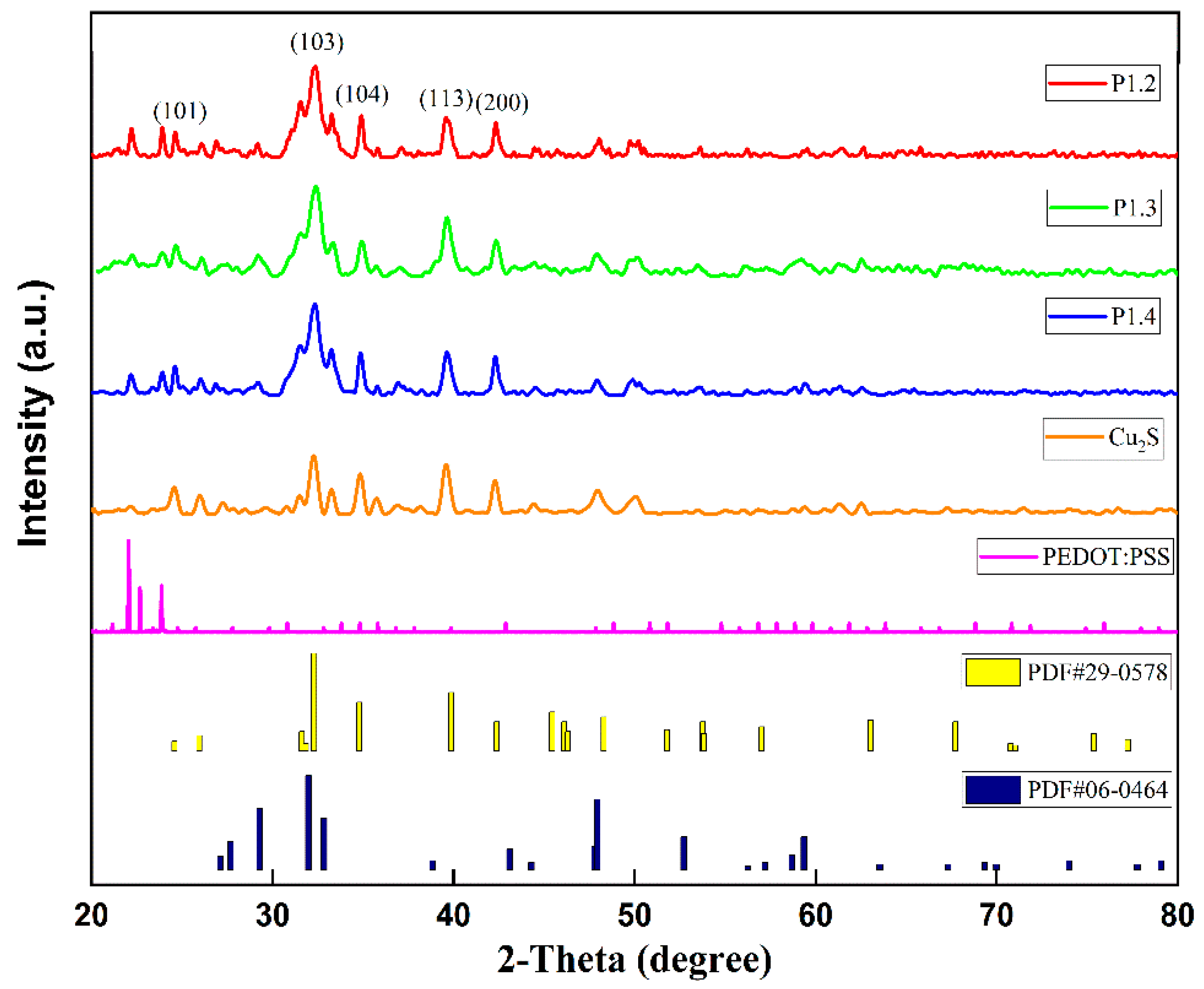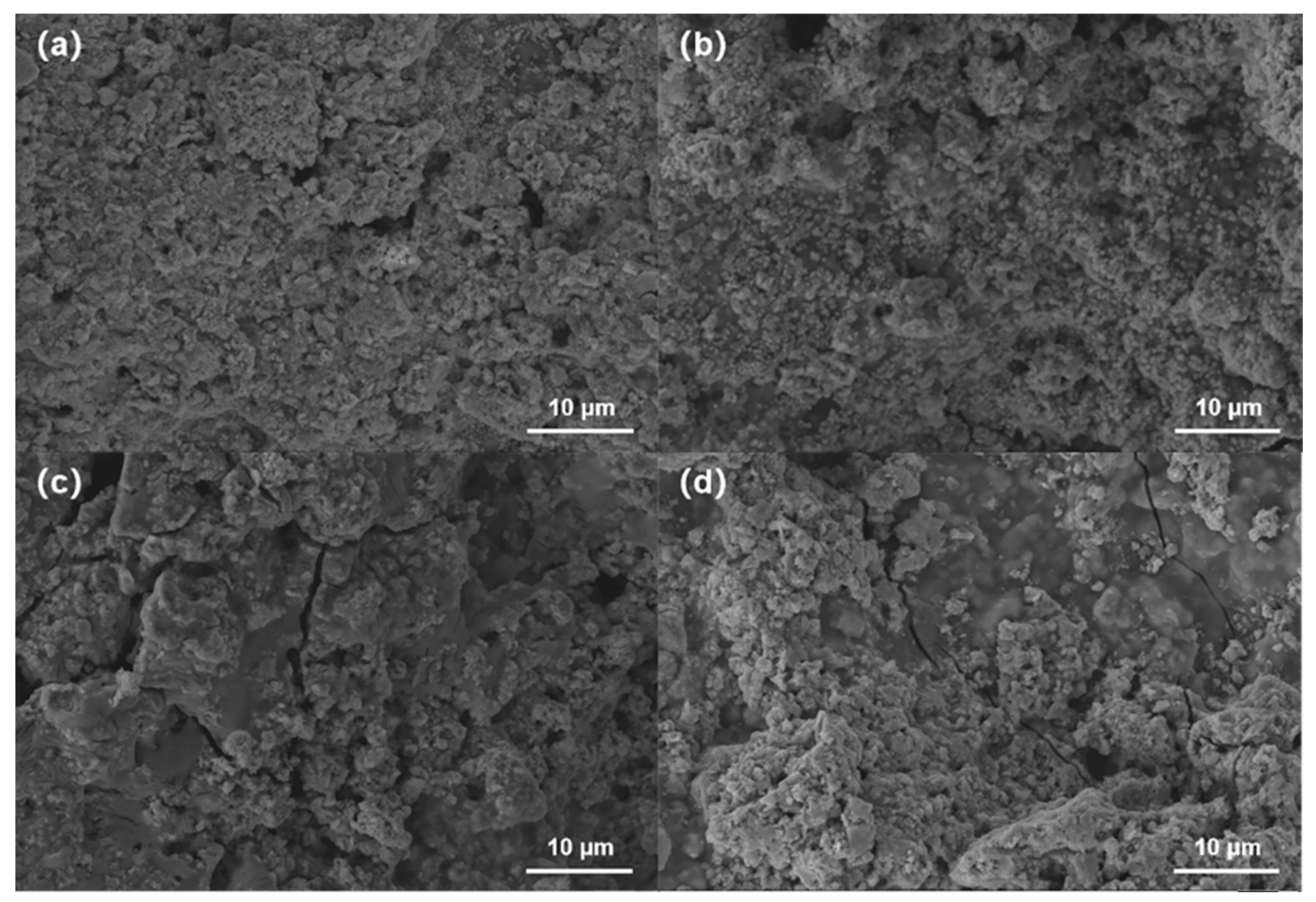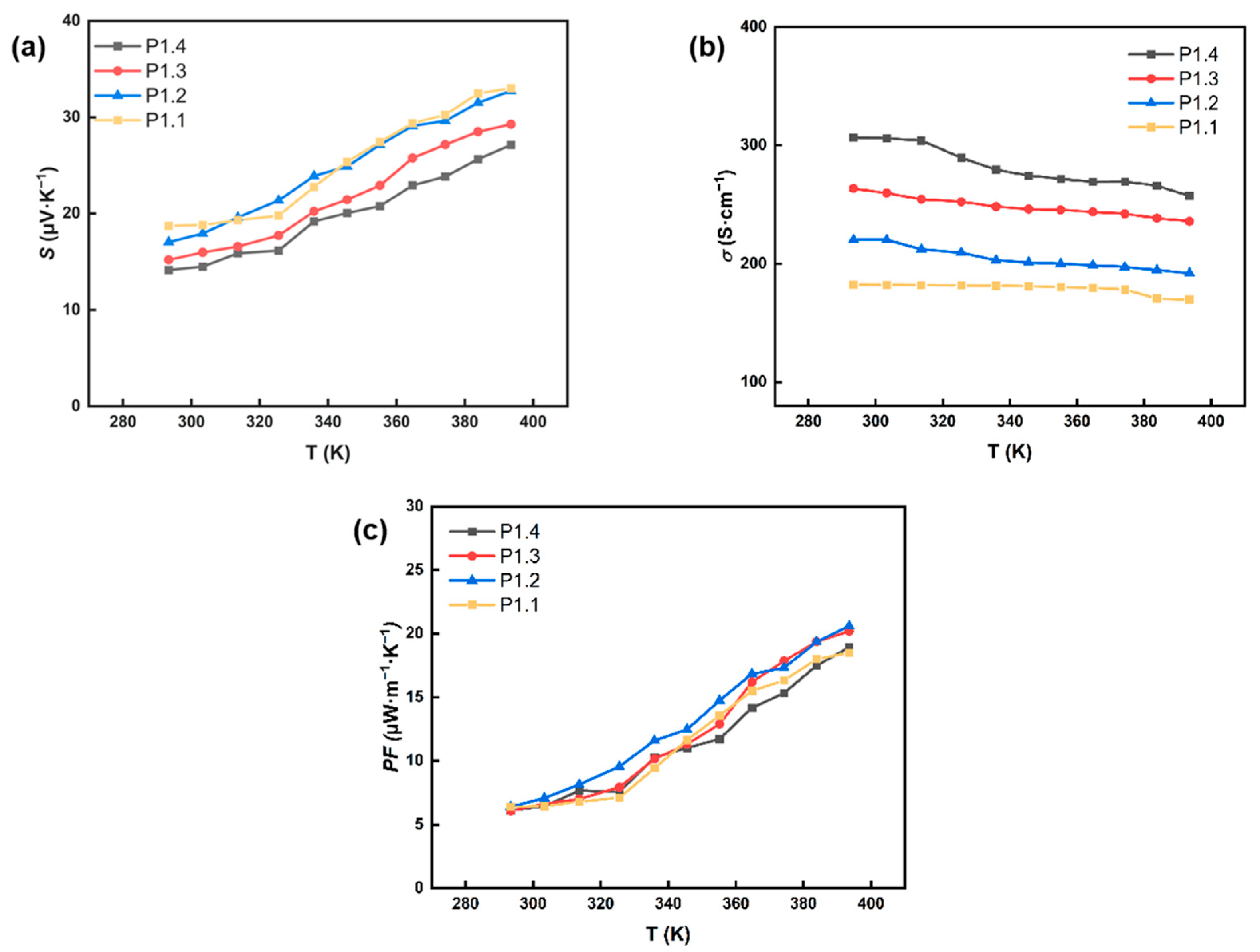Preparation and Characterization of Screen-Printed Cu2S/PEDOT:PSS Hybrid Films for Flexible Thermoelectric Power Generator
Abstract
:1. Introduction
2. Experimental Procedures
2.1. Material
2.2. Preparation of Flexible Thermoelectric Thin Film
2.3. Measurements and Characterizations of Cu2S/PEDOT:PSS Film and f-TEG
3. Results and Discussion
4. Conclusions
Supplementary Materials
Author Contributions
Funding
Data Availability Statement
Conflicts of Interest
References
- Ma, Y.; Ahlberg, E.; Sun, Y.; Iversen, B.B.; Palmqvist, A.E.C. Thermoelectric Characteristics of Electrochemically Deposited Bi2Te3 and Sb2Te3 Thin Films of Relevance to Multilayer Preparation. J. Electrochem. Soc. 2011, 159, 50–58. [Google Scholar] [CrossRef]
- Yamamoto, A.; Hagino, H.; Hashimoto, Y.; Miyazaki, K. The Effects of Thermoelectric Film Thickness on Performance of In-Plane Thermoelectric Modules. J. Electron. Mater. 2012, 41, 1799–1804. [Google Scholar] [CrossRef]
- Kim, S.J.; We, J.H.; Kim, G.S.; Cho, B.J. Simultaneous measurement of the Seebeck coefficient and thermal conductivity in the cross-sectional direction of thermoelectric thick film. J. Appl. Phys. 2012, 112, 104511. [Google Scholar] [CrossRef]
- Shi, X.L.; Zou, J.; Chen, Z.G. Advanced Thermoelectric Design: From Materials and Structures to Devices. Chem. Rev. 2020, 120, 7399–7515. [Google Scholar] [CrossRef]
- Bartholomé, K.; Jägle, M.; Ebling, D.G.; König, J.; Jacqot, A.; Böttner, H. Energieautarke Sensorik im Flugzeug. Tech. Mess. 2010, 77, 445–451. [Google Scholar] [CrossRef]
- Kanahashi, K.; Pu, J.; Takenobu, T. 2D Materials for Large-Area Flexible Thermoelectric Devices. Adv. Energy Mater. 2019, 10, 1902842. [Google Scholar] [CrossRef]
- Matsuzaki, Y.; Jovanovic, V.; Ghamaty, S. Design, fabrication, and testing of energy-harvesting thermoelectric generator. In Proceedings of the SPIE 6173, Smart Structures and Materials 2006: Smart Structures and Integrated Systems, San Diego, CA, USA, 5 April 2006. [Google Scholar] [CrossRef]
- Cornett, J.; O’Grady, A.; Vouaillat, A.; Michaud, J.; Muret, F.; Weatherholtz, W.; Bai, J.; Dunham, M.; Riehl, P.; Chen, B.; et al. Continuous Machine Health Monitoring Enabled Through Self-Powered Embedded Intelligence and Communication. J. Phys. Conf. Ser. 2018, 1052, 012025. [Google Scholar] [CrossRef]
- Snyder, G.J.; Toberer, E.S. Complex thermoelectric materials. Nat. Mater. 2008, 7, 105–114. [Google Scholar] [CrossRef] [Green Version]
- Jaldurgam, F.F.; Ahmad, Z.; Touati, F.; Ashraf, A.A.; Bhadra, J.; Altahtamouni, T.; Al-Thani, N.J. Thermal and mechanical stability of microwave sintered cold compact bismuth telluride thermoelectric material. Mater. Today Commun. 2020, 31, 103345. [Google Scholar] [CrossRef]
- Feinaeugle, M.; Sones, C.L.; Koukharenko, E.; Eason, R.W. Fabrication of a thermoelectric generator on a polymer-coated substrate via laser-induced forward transfer of chalcogenide thin films. Smart Mater. Struct. 2013, 22, 115023. [Google Scholar] [CrossRef]
- Chen, Y.; Hou, X.; Ma, C.; Dou, Y.; Wu, W. Review of Development Status of Bi2Te3-Based Semiconductor Thermoelectric Power Generation. Adv. Mater. Sci. Eng. 2018, 2018, 1–9. [Google Scholar] [CrossRef] [Green Version]
- Hsiao, C.-C.; Wu, Y.-S. Fabrication of flexible thin-film thermoelectric generators. J. Chin. Inst. Eng. 2011, 34, 809–816. [Google Scholar] [CrossRef]
- Ou, C.; Sangle, A.L.; Datta, A.; Jing, Q.; Busolo, T.; Chalklen, T.; Narayan, V.; Kar-Narayan, S. Fully Printed Organic-Inorganic Nanocomposites for Flexible Thermoelectric Applications. ACS Appl. Mater. Interfaces 2018, 10, 19580–19587. [Google Scholar] [CrossRef]
- Kato, K.; Hagino, H.; Miyazaki, K. Fabrication of Bismuth Telluride Thermoelectric Films Containing Conductive Polymers Using a Printing Method. J. Electron. Mater. 2013, 42, 1313–1318. [Google Scholar] [CrossRef]
- Recatala-Gomez, J.; Kumar, P.; Suwardi, A.; Abutaha, A.; Nandhakumar, I.; Hippalgaonkar, K. Direct measurement of the thermoelectric properties of electrochemically deposited Bi2Te3 thin films. Sci. Rep. 2020, 10, 17922. [Google Scholar] [CrossRef]
- Perez-Taborda, J.A.; Caballero-Calero, O.; Vera-Londono, L.; Briones, F.; Martin-Gonzalez, M. High Thermoelectric zT in n-Type Silver Selenide films at Room Temperature. Adv. Energy Mater. 2018, 8, 1702024. [Google Scholar] [CrossRef]
- Liu, X.; Wang, D.; Wu, H.; Wang, J.; Zhang, Y.; Wang, G.; Pennycook, S.J.; Zhao, L.-D. Intrinsically Low Thermal Conductivity in BiSbSe3: A Promising Thermoelectric Material with Multiple Conduction Bands. Adv. Funct. Mater. 2019, 29, 1806558. [Google Scholar] [CrossRef]
- Guin, S.N.; Chatterjee, A.; Biswas, K. Enhanced thermoelectric performance in p-type AgSbSe2 by Cd-doping. RSC Adv. 2014, 4, 11811. [Google Scholar] [CrossRef]
- Zheng, Z.-H.; Wang, T.; Jabar, B.; Ao, D.-W.; Li, F.; Chen, Y.-X.; Liang, G.-X.; Luo, J.-T.; Fan, P. Enhanced Thermoelectric Performance in n-Type Bi2O2Se by an Exquisite Grain Boundary Engineering Approach. Acs Appl. Energy Mater. 2021, 4, 10290–10297. [Google Scholar] [CrossRef]
- Ruan, M.; Li, F.; Chen, Y.; Zheng, Z.; Fan, P. Te-free compound Bi2SeS2 as a promising mid-temperature thermoelectric material. J. Alloys Compd. 2020, 849, 156677. [Google Scholar] [CrossRef]
- Samanta, M.; Pal, K.; Pal, P.; Waghmare, U.V.; Biswas, K. Localized Vibrations of Bi Bilayer Leading to Ultralow Lattice Thermal Conductivity and High Thermoelectric Performance in Weak Topological Insulator n-Type BiSe. J. Am. Chem. Soc. 2018, 140, 5866–5872. [Google Scholar] [CrossRef] [PubMed]
- Ding, Y.; Qiu, Y.; Cai, K.; Yao, Q.; Chen, S.; Chen, L.; He, J. High performance n-type Ag2Se film on nylon membrane for flexible thermoelectric power generator. Nat. Commun. 2019, 10, 1–7. [Google Scholar] [CrossRef] [PubMed] [Green Version]
- Mulla, R.; Rabinal, M.K. Ambient growth of highly oriented Cu2S dendrites of superior thermoelectric behavior. Appl. Surf. Sci. 2017, 397, 70–76. [Google Scholar] [CrossRef]
- Cui, Y.; Duan, S.; Chen, X.; Liu, X. Remarkable electronic band structure leads to high thermoelectric properties in p-type γ-Cu2S. Vacuum 2019, 170, 108964. [Google Scholar] [CrossRef]
- Zhang, Q.H.; Huang, X.Y.; Bai, S.Q.; Shi, X.; Uher, C.; Chen, L.D. Thermoelectric Devices for Power Generation: Recent Progress and Future Challenges. Adv. Eng. Mater. 2016, 18, 194–213. [Google Scholar] [CrossRef]
- Jaziri, N.; Boughamoura, A.; Müller, J.; Mezghani, B.; Tounsi, F.; Ismail, M. A comprehensive review of Thermoelectric Generators: Technologies and common applications. Energy Rep. 2020, 6, 264–287. [Google Scholar] [CrossRef]
- Lv, Y.; Chen, J.; Zheng, R.K.; Song, J.; Zhang, T.; Li, X.; Shi, X.; Chen, L. Photo-induced enhancement of the power factor of Cu2S thermoelectric films. Sci. Rep. 2015, 5, 16291. [Google Scholar] [CrossRef] [Green Version]
- Liu, D.; Yan, Z.; Zhao, Y.; Zhang, Z.; Zhang, B.; Shi, P.; Xue, C. Facile self-supporting and flexible Cu2S/PEDOT:PSS composite thermoelectric film with high thermoelectric properties for body energy harvesting. Results Phys. 2021, 31, 105061. [Google Scholar] [CrossRef]
- Yu, J.; Li, T.; Nie, G.; Zhang, B.P.; Sun, Q. Ultralow lattice thermal conductivity induced high thermoelectric performance in the delta-Cu2S monolayer. Nanoscale 2019, 11, 10306–10313. [Google Scholar] [CrossRef]
- Li, Y.P.; Huang, G.H.; Liu, Y.Y.; Zhang, Y.M.; Nie, S.L. An inexact stochastic quadratic programming method for municipal solid waste management. Civ. Eng. Environ. Syst. 2008, 25, 139–155. [Google Scholar] [CrossRef]
- Patel, T.A.; Panda, E. Thickness induced microstructure, electronic structure and optoelectronic properties of Cu2S films deposited by radio frequency magnetron sputtering. J. Appl. Phys. 2019, 126, 245101. [Google Scholar] [CrossRef]
- Chu, J.; Ren, B.; Huang, J.; Wang, L.; Tang, K.; Qin, K.; Pan, Z.; Wang, L.; Xia, Y.; Wang, C. Effects of substrate temperature on morphology, structure and chemical composition of Cu2S films. Eighth Int. Conf. Thin Film. Phys. Appl. 2013, 12, 9068. [Google Scholar] [CrossRef]
- Liang, D.-D.; Zhang, B.-P.; Zou, L. Enhanced thermoelectric properties of Cu1.8S by Ti-doping induced secondary phase. J. Alloys Compd. 2018, 731, 577–583. [Google Scholar] [CrossRef]
- Liu, D.; Zhao, Y.; Yan, Z.; Zhang, Z.; Zhang, Y.; Shi, P.; Xue, C. Screen-Printed Flexible Thermoelectric Device Based on Hybrid Silver Selenide/PVP Composite Films. Nanomaterials 2021, 11, 2042. [Google Scholar] [CrossRef] [PubMed]
- Varghese, T.; Hollar, C.; Richardson, J.; Kempf, N.; Han, C.; Gamarachchi, P.; Estrada, D.; Mehta, R.J.; Zhang, Y. High-performance and flexible thermoelectric films by screen printing solution-processed nanoplate crystals. Sci. Rep. 2016, 6, 33135. [Google Scholar] [CrossRef] [Green Version]
- Lee, H.B.; We, J.H.; Yang, H.J.; Kim, K.; Choi, K.C.; Cho, B.J. Thermoelectric properties of screen-printed ZnSb film. Thin Solid Film. 2011, 519, 5441–5443. [Google Scholar] [CrossRef]
- Liu, Y.; Ren, W.; Shi, P.; Liu, D.; Zhang, Y.; Liu, M.; Ye, Z.G.; Jing, W.; Tian, B.; Jiang, Z. A Highly Thermostable In2O3/ITO Thin Film Thermocouple Prepared via Screen Printing for High Temperature Measurements. Sensors 2018, 18, 958. [Google Scholar] [CrossRef] [Green Version]
- Tsuruta, A.; Tanaka, M.; Mikami, M.; Kinemuchi, Y.; Masuda, Y.; Shin, W.; Terasaki, I. Development of Na0.5CoO2 Thick Film Prepared by Screen-Printing Process. Materials 2020, 13, 2805. [Google Scholar] [CrossRef]
- Liu, D.; Zhao, Y.; Guo, R.; Liu, Y.; Zhang, Z.; Zhang, Z.; Xue, C. Effect of Annealing Conditions on the Thermoelectric Properties of Magnetron Sputtered MgO-Ag3Sb-Sb2O4 Flexible Films. J. Inorg. Mater. 2022, in press. [Google Scholar] [CrossRef]








| Element (%) | Weight (%) | Atom (%) |
|---|---|---|
| Cu | 65.3 | 35.21 |
| S | 15.51 | 16.57 |
| C | 10.03 | 28.6 |
| O | 9.16 | 19.62 |
| Total | 100 | 100 |
Publisher’s Note: MDPI stays neutral with regard to jurisdictional claims in published maps and institutional affiliations. |
© 2022 by the authors. Licensee MDPI, Basel, Switzerland. This article is an open access article distributed under the terms and conditions of the Creative Commons Attribution (CC BY) license (https://creativecommons.org/licenses/by/4.0/).
Share and Cite
Zhao, J.; Zhao, X.; Guo, R.; Zhao, Y.; Yang, C.; Zhang, L.; Liu, D.; Ren, Y. Preparation and Characterization of Screen-Printed Cu2S/PEDOT:PSS Hybrid Films for Flexible Thermoelectric Power Generator. Nanomaterials 2022, 12, 2430. https://doi.org/10.3390/nano12142430
Zhao J, Zhao X, Guo R, Zhao Y, Yang C, Zhang L, Liu D, Ren Y. Preparation and Characterization of Screen-Printed Cu2S/PEDOT:PSS Hybrid Films for Flexible Thermoelectric Power Generator. Nanomaterials. 2022; 12(14):2430. https://doi.org/10.3390/nano12142430
Chicago/Turabian StyleZhao, Junmei, Xiaolong Zhao, Rui Guo, Yaxin Zhao, Chenyu Yang, Liping Zhang, Dan Liu, and Yifeng Ren. 2022. "Preparation and Characterization of Screen-Printed Cu2S/PEDOT:PSS Hybrid Films for Flexible Thermoelectric Power Generator" Nanomaterials 12, no. 14: 2430. https://doi.org/10.3390/nano12142430
APA StyleZhao, J., Zhao, X., Guo, R., Zhao, Y., Yang, C., Zhang, L., Liu, D., & Ren, Y. (2022). Preparation and Characterization of Screen-Printed Cu2S/PEDOT:PSS Hybrid Films for Flexible Thermoelectric Power Generator. Nanomaterials, 12(14), 2430. https://doi.org/10.3390/nano12142430






